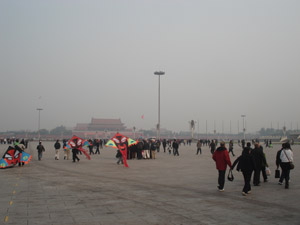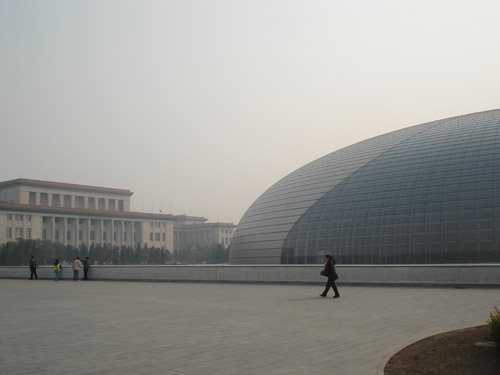nov-5-07 |
||||||
| blogs pics videoschris' page jill's page links contact us home |
|
|||||
Unfortunately the Mausolium was closed on Mondays so we were not able to go inside and see his remains. As we continued to walk North in the square, following the crowd, we noticed more vendors looking to sell Unfortunately the Chinese government has blocked access to wikipedia so I can't give you a link to more info about the square itself but I can give you this cool panorama link of the famous square that was built to hold over a million people. At the north end of Tiananmen Square sits Tiananmen (or Gate of Heavenly Peace). This gate is the opening to the Forbidden city, but it has become one of the most recognizable signs of modern China due to the large likeness of Mao above the main entrance.
Still venturing further north, you come upon an number of other gates leading The city really is a city! After walking around for 3.5 hours we felt like we had only scratched the surface of what there was to see. From palaces to gates, to galaries of various period artifacts, Chris was in historian heaven! We took at least 150 pictures during our walk and several of them can be seen on our picture page.
When we left the Forbidden City we decided to walk around the outside for a while. There are some beautiful parks and pathways that lead you around the high walls and wide moat of the exterior. We then headed south west towards the National Grand Theatre. One of the modern marvels of Beijing's facelift in time for the Olympics, the Grand Theatre is built in the shape of a "giant egg". Set against the backdrop of Beijing's old communist landmarks, this marvel of engineering and vision represents China's desire to achieve great things in archetectural showpieces when the world visits next summer. This change has not come with a change in communist values however. When the plans for 'the egg' were being approved, the government made the engineers sink the egg into the ground so that the total height of the building would not dwarf the height of it's neighbour 'The Great Hall of the People', a giant insult to the Chinese people. So in respect for these values the Grand Theatre was build several feet below the Government Hall.
Although we were rather tired from a long day of walking, we couldn't help but head south of Qianmen to scout the streets for some bargains. Trying our hands at bartering was difficult at first but we quickly got the hang of things. We came away with some nice paintings and textiles at very good prices. Our best technique in the negotiation process seemed to be offering them 1/4 of the initial asking price, then once we got the seller down to 1/2 the initial price, we would walk away until they would offer the 1/4 we asked for in the first place. 10 hours after setting out, we headed back to Terry and Kate's house. Exhausted, we were delighted to see that their Ah-ee had made supper for all of us. It was delicious! We went to bed physically tired but energetic about tomorrow's trip to the Great Wall.
|
|
|
 various trinkets, and especially kytes (left) for people to fly in the square. As we reached the midpoint of the square we stopped to see the 'Monument to the People's Heroes' and looked to our left to see the large 'Great Hall of the People' (the rubberstamp Chinese National Assembly) and to the right the 'National Museum' equipped with a large Olympic countdown clock in the front entrance. The square itself has become a famous rallying point for both national propeganda and protest. Many will still remember the Tiananmen Square protests of 1989, and further back in history the many rallies held there during the 'Cultural Revolution' of the late 60's.
various trinkets, and especially kytes (left) for people to fly in the square. As we reached the midpoint of the square we stopped to see the 'Monument to the People's Heroes' and looked to our left to see the large 'Great Hall of the People' (the rubberstamp Chinese National Assembly) and to the right the 'National Museum' equipped with a large Olympic countdown clock in the front entrance. The square itself has become a famous rallying point for both national propeganda and protest. Many will still remember the Tiananmen Square protests of 1989, and further back in history the many rallies held there during the 'Cultural Revolution' of the late 60's. 